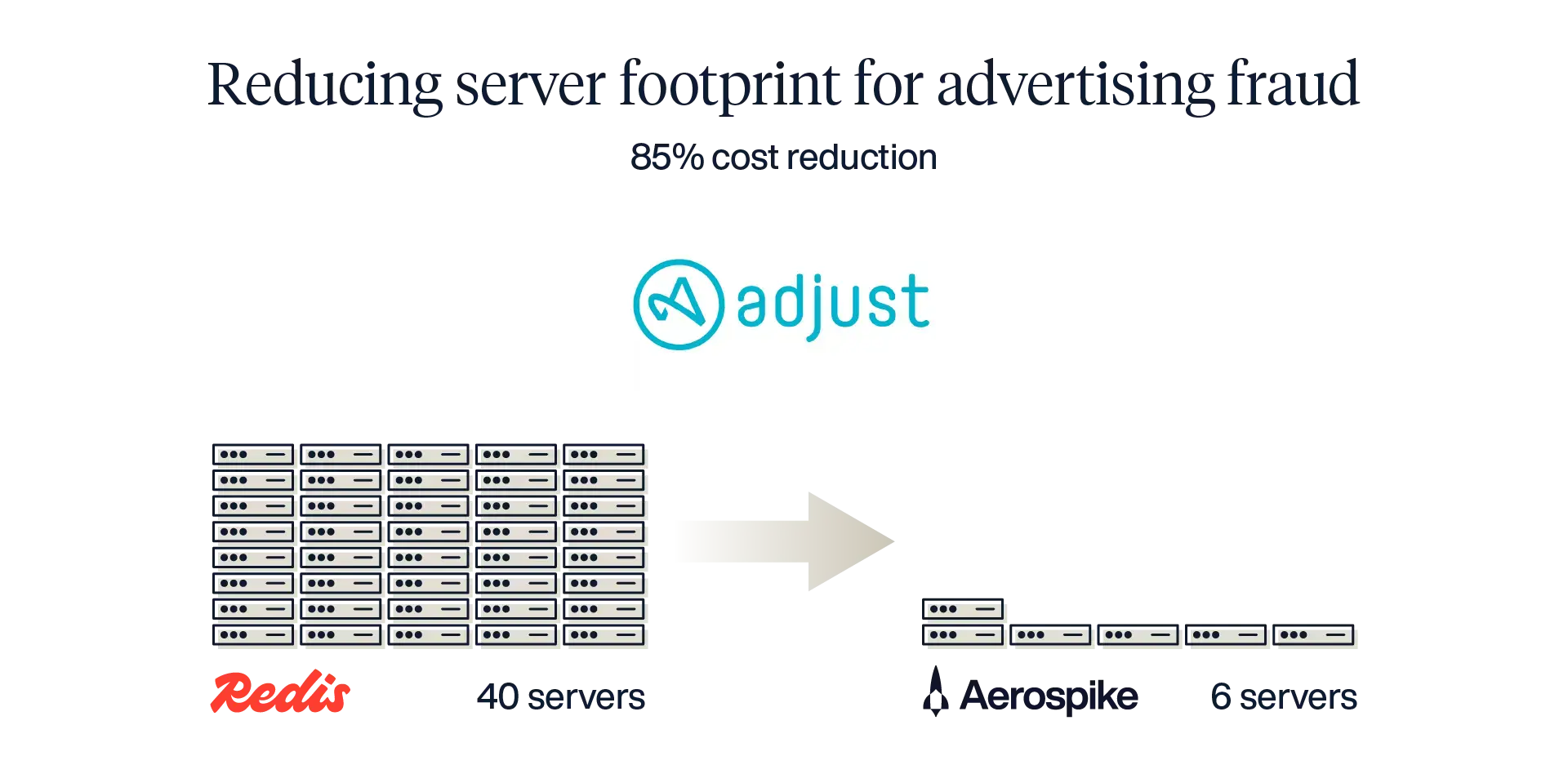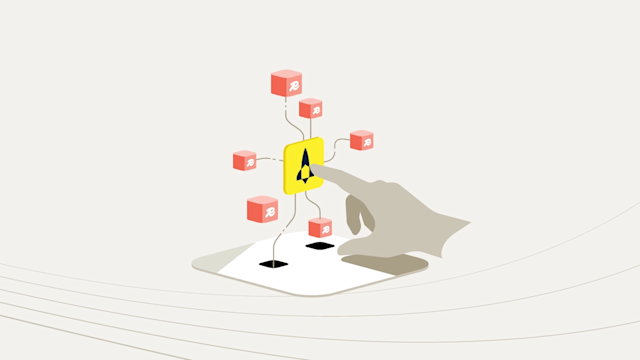How Aerospike outperforms Redis in efficiency
Understand how Redis’ inefficiencies grow with scale. Aerospike offers better performance, lower costs, and a sustainable solution for real-time database needs.
As businesses scale real-time data workloads, the environmental and financial costs of inefficient database operations soar. While Redis has long been valued for its speed, its design requires more servers, uses more energy, and makes it hard and expensive to scale. Aerospike, by contrast, delivers superior performance, scalability, and sustainability through its innovative architecture.
Below, we explore how Aerospike reduces operational and environmental costs while helping enterprises meet their data needs, offering the performance and reliability expected from a truly strong database. With real-world examples and hard metrics, we’ll demonstrate why Aerospike stands out as the clear choice over Redis, which excels as a cache but falls short as a primary database.
The environmental costs of Redis server sprawl
Because Redis is an in-memory data store, it relies on DRAM (Dynamic Random-Access Memory) to deliver fast performance. However, this reliance on memory doesn’t scale and is not sustainable:
Excessive hardware requirements: Redis requires more memory than data, which is inefficient. As data grows, organizations have to deploy more servers.
Inability to scale vertically: Redis’ single-threaded design cannot take advantage of multi-core processors, forcing horizontal scaling instead.
Environmental toll: Adding servers uses more energy, generates more heat (requiring additional cooling), and takes up more space.
Aerospike’s architecture: A sustainable solution for modern workloads
In comparison to Redis, Aerospike’s patented Hybrid Memory Architecture (HMA) favors fewer, “fatter” cluster nodes that combine DRAM, SSDs/flash storage to deliver in-memory performance without the energy-intensive overhead of Redis. Aerospike’s design enables businesses to:
Scale vertically: Aerospike’s multi-threaded architecture takes advantage of modern multi-core processors, reducing the need for more servers.
Use storage efficiently: Metadata and indexes reside in DRAM, while data is moved to low-cost, energy-efficient SSDs.
Simplify persistence and storage: While Redis relies on periodic snapshots, append-only files (AOF), or add-on solutions such as Speedb or RocksDB for persistence and storage, Aerospike has a unified storage model and integrated data persistence out of the box.
Real-world example: Adjust’s infrastructure inefficiency with Redis

Adjust, an AdTech firm specializing in fraud prevention, initially struggled with Redis server sprawl. Managing its infrastructure required 40 servers just to meet performance demands.
“Within one and a half years, we grew from one to over 40 servers, and we had to add two new machines every two weeks,” said Robert Abraham, vice president of engineering.
After transitioning to Aerospike, Adjust reduced its server count from 40 Redis servers to just six (6) Aerospike servers, lowering infrastructure costs by 85% while improving data latency, failover reliability, and accuracy.
Real-world comparisons: Aerospike vs. Redis efficiency
The inefficiencies of Redis' memory-first, scale-out architecture become clear when comparing real-world outcomes.
Node efficiency: Aerospike needs up to 87% fewer nodes than Redis for comparable workloads.
TCO savings: Aerospike customers routinely enjoy up to 80% lower total cost of ownership (TCO) compared with Redis.
Energy savings: Fewer servers mean lower energy consumption, reduced cooling needs, and a smaller carbon footprint.
Example: ironSource’s performance transformation
ironSource, another AdTech firm, replaced Redis with Aerospike to deliver ads more efficiently.
“Redis just couldn't scale up and meet our demands,” said Gil Shoshan, a backend developer on the mobile delivery team for IronSource. “We couldn't add any more IOPS and storage, and our DevOps team effort to support a cluster was becoming overbearing.”
With Aerospike ironSource achieved:
130,000 reads and 75,000 writes per second
Near 100% uptime with sub-millisecond latency
Improved performance and sustainability with fewer servers
Redis memory: Inefficient use of resources
Redis’ in-memory operations are fast, but you’ll pay for it when you need persistence:
Operational complexity: Because Redis users need external tools such as Speedb or RocksDB for persistence, they need more infrastructure, CPU allocation, and maintenance.
Limited scalability during persistence: Redis persistence mechanisms, such as append-only files (AOFs) and snapshots, introduce system pauses when persisting data to disk. These pauses are major performance disruptors amid write-heavy operations, which could affect the database's overall responsiveness.
Performance inefficiency: Redis' benchmarks often exclude persistence, masking the real-world energy and hardware costs.
Aerospike’s integrated persistence advantage
Aerospike eliminates these issues by integrating persistence in all operating modes while also being optional for higher-performance scenarios. It delivers reliable sub-millisecond latencies with mixed workloads, providing predictable, energy-efficient performance.
Quantifying sustainability: Aerospike’s environmental edge
Organizations adopting Aerospike achieve measurable sustainability benefits compared to Redis deployments:
Server reduction by up to 80%: Aerospike manages petabyte-scale workloads with a fraction of the servers Redis needs.
Energy efficiency: Aerospike’s efficient use of flash storage uses less power than Redis' memory-intensive operations.
Reduced cooling requirements: By consolidating workloads onto fewer, denser nodes, Aerospike generates less heat, reducing the energy needed for cooling.
Example: AppsFlyer’s scalability challenge
AppsFlyer, a global mobile marketing platform, needed to scale operations to handle explosive data growth, and Redis struggled to keep up.
“We weren’t happy with this solution,” said Shaked Zychlinski, a data engineer at the time. "The memory required to cache will scale, and we didn’t like the fact we had a production process that literally pushes its framework to its absolute limit."
AppsFlyer migrated 2 billion records to Aerospike, resulting in a smaller, more stable infrastructure that could scale from 1.4 billion to 5 billion devices in a year.
The carbon footprint equation: Redis vs. Aerospike
Let’s break down the carbon footprint impact of Redis compared to Aerospike:
Redis scaling formula: Redis’ memory-intensive nodes mean you need more memory than the data, which leads to server sprawl, higher deployment costs, more energy consumed, and therefore more carbon produced.
Aerospike scaling formula: Aerospike’s HMA has far fewer but denser nodes, leading to lower energy costs and a smaller carbon footprint.
Real-world example: TomTom’s environmental transformation
TomTom, a global navigation and mapping solutions leader, wanted to reduce operational costs and environmental impact. By switching to Aerospike, TomTom achieved:
93% reduction in operational costs
86% reduction in carbon footprint
5x lower CO₂ emissions while maintaining performance
Savings of up to 100K Euros per outage avoided
These outcomes show how Aerospike’s efficient design helps enterprises meet sustainability targets.
Aerospike delivers sustainability and performance
Aerospike’s architecture solves Redis’ sustainability and scalability challenges. By using resources more efficiently and reducing the number of servers, Aerospike helps businesses maintain high performance with less environmental impact.
Key benefits include:
Up to 87% fewer servers for comparable workloads
93% reduction in operational costs, as demonstrated by TomTom
85% infrastructure savings, as shown by Adjust
For organizations that want to make their technology more sustainable, Aerospike represents a provable alternative. Aerospike delivers a greener, more sustainable path forward for real-time data operations by reducing energy usage, cooling demands, and hardware footprints.
If sustainability and efficiency are priorities for your enterprise, the data speaks for itself: Aerospike outclasses Redis on every front.




